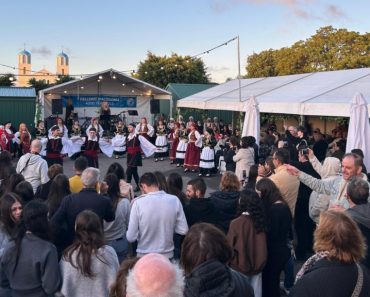This autumn kicks off dynamically at the National Museum of Contemporary Art (EMST). Visitors and lovers of modern art will find two compelling exhibitions opening on the museum’s third floor on November 8, marking a strong start to the museum’s late-fall program.
The first, “The Greek Month in London”, is part of EMST’s ongoing effort to cultivate creative practices of memory — standing against a prevailing culture of amnesia toward the past. The exhibition revisits the landmark cultural event that took place in London in November–December 1975, which helped ignite early discussions on contemporary art and avant-garde practices in post-dictatorship Greece.
The second exhibition, “Sea Garden”, the result of EMST’s second open call for curating a group show, explores natural landscapes and the elusive traces of human presence within them. The exhibition contemplates the fragile coexistence between dryness and liquidity, a dialogue of existing and newly commissioned works that capture that fleeting threshold where land meets sea.
What Was The Greek Month in London
On November 4, 1975, following the French and German cultural months that preceded it, the Press Office of the Greek Embassy in London, supported by the National Trust for Greece, launched The Greek Month in London. The aim was “to present to the English public an image of Greece’s contemporary cultural vitality, while acknowledging those elements of the past that continue to influence the country’s intellectual creation.”
The program offered a rich and diverse panorama of Greek artistic and intellectual activity: visual art exhibitions, a Greek Film Week featuring works by Nikos Koundouros, Michael Cacoyannis, and Theodoros Angelopoulos, evenings of dance, music, and poetry, as well as exhibitions dedicated to Giorgos Seferis, to the resistance press of the junta years, and to contemporary Greek writers presented by the National Book Centre.
Its visual arts component included two major exhibitions: Four Painters of 20th Century Greece and Eight Artists, Eight Attitudes, Eight Greeks — the latter now revived by EMST to mark its 50th anniversary.
Greek Artists and European Culture after the Dictatorship
As noted in the original exhibition catalogue, Eight Artists, Eight Attitudes, Eight Greeks marked the first time that two generations of distinguished Greek artists — those based in Greece and those working abroad — were presented side by side. The curatorial framework explored the relationship between Greek artists and European culture in the immediate aftermath of the junta’s fall, addressing questions of national identity, cultural singularity, and the tension between Greece’s glorious past and its contemporary reality.
Curated by Polina Kosmadaki, EMST’s revival of The Greek Month in London sheds light on the significance of Christos Joachimides and Sir Norman Rosenthal’s curatorial vision in shaping the notion of a “Greek avant-garde,” as well as the exhibitions’ role in the broader political discourse on socially engaged artistic practice during Greece’s transition to democracy.
The exhibition includes artworks, documents, and archival material developed from discussions between the curator and Joachimides before his passing — much of which is being presented to the public for the first time.

Works by the Greek American artist Chryssa (Chryssa Vardea-Mavromichali) in the exhibition ‘Eight Artists, Eight Attitudes, Eight Greeks’ at the ICA, London.
Featured artists include Stephen Antonakos, Vlassis Caniaris, Chryssa, Jannis Kounellis, Pavlos, Lucas Samaras, Takis, and Costas Tsoclis — with works drawn from EMST’s collection and other Greek collections, echoing those originally shown at London’s ICA in 1975. The exhibition is accompanied by original texts and an illustrated timeline.
EMST Turns into a Sea Garden
Opening on the same day, November 8, Sea Garden — curated by Danae Yannoglou and Kyveli Mavrokordopoulou — is part of EMST’s 2025 program of rotating exhibitions. Borrowing its title from the eponymous poetry collection by H.D. (Hilda Doolittle, 1886–1961), the show gathers works that embody and reflect on landscapes and the subtle human traces embedded within them.
The exhibition unfolds as a meditation on terrains viewed through watery iridescence, landscapes soaked in the toxic promises of industrialization, or bodies concealed and sheltered by the land itself. Other works evoke sun-scorched fields and terrains of questions and responses.

Ana Mendieta, Untitled (Volcano Series No. 2), 1979 | Part of the D.Daskalopoulos Collection Gift | EMST Collection
Taking as a point of departure the practice of Athina Tacha and, more specifically, her works held in the EMST collection, Sea Garden opens a dialogue on the landscape as a category under pressure. While not limited to the Greek territory, it consistently returns to the complexities of the Greek and Mediterranean geopolitical context.
Tacha’s practice converses with the ecological sensitivity of Margaret Raspé (1933–2023), particularly the series she developed in her summer residence on the island of Karpathos during the 1970s and 1980s. The Sparoza Garden in Paiania — cultivated by women volunteers since the 1960s — becomes both the literal and metaphorical matter of artist and filmmaker Catriona Gallagher’s work.
Dora Economou subtly collects elements from natural organisms across the globe to create sculptural mutations blurring the boundaries between host and parasite. Claude Cahun (1894–1954) embodies nature itself to resist fixed notions of gender and identity, while Ana Mendieta (1948–1985), whose work also belongs to EMST’s collection, imprints her body on the landscape only to erase it immediately using the four elements of nature.
Sea Garden explores the paradoxical yet essential interplay between aridity and liquidity — where rising waters threaten floods while their absence foretells merciless heat. The exhibition combines existing and new works to illuminate that fleeting moment where earth and sea converge, inviting us to imagine the edge as stage, symbol, and system — and to rethink boundaries of environment, labor, gender, and migration.
Accompanied by the public program I Even Lost My Shadow, featuring Stefanos Levidis, Danae Io, Margaret Raspé, Catriona Gallagher, and Fredj Moussa, Sea Garden is the outcome of EMST’s second open call for curating a group exhibition — a key initiative supporting curatorial research and fostering new opportunities for professionals in contemporary art. The program reinforces the museum’s pluralistic spirit, inviting proposals that engage in dialogue with EMST’s Collection and Archive.







